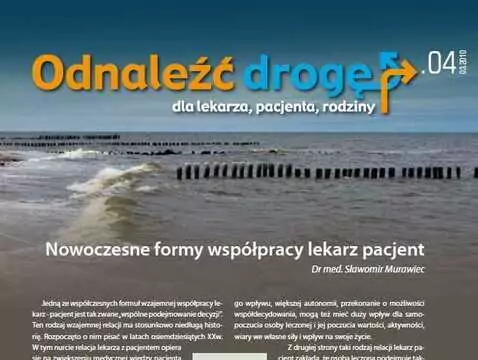Prejudices and prejudices against mentally ill people have a long tradition. They are commonly encountered and have a negative impact on the prognosis and course of the illness. People with schizophrenia often face discrimination and rejection in everyday life. Society, legislators, employers, the media and even some doctors perpetuate the stereotypical view of people with schizophrenia as dangerous, aggressive and unable to work effectively.
Educational programme
The educational programme aims to build on the previous experience of many teams
in training about schizophrenia. It will be enriched with the following aspects:
- In addition to the traditional groups subjected to the training such as psychiatric and social work staff, the information programme will be extended to:
- psychiatric patients and their families
- employers
- priests and seminarians
- teachers
- local government politicians
- journalists
- In addition to professionals, families of patients and patients as "disease educators" will be involved as trainers (Patients' Associations will be set up, which would focus on this activity)
- Cooperation with the Church will be developed in order to train clerics in particular in a new perspective on mental illness
- There are plans to prepare accessible guides for families and patients or to re-edit them. 5. Activities in the national forum will be linked to periodic symposia on schizophrenia and social issues organised by various centres in the country, which provide a training forum and at the same time an opportunity for contacts with the media (press conferences). At the same time, it is an opportunity to meet in a group of "National Coordinators", as the participants are usually lecturers at these Symposia, and an opportunity to regularly review the course of the programme.
Practical activities
Practical action takes place in local and national forums. In order to make the information provided more accessible and attractive, it is planned to prepare a nationwide schedule of vernissages, artistic activities under the general title of "Together in Life and Art". Such events should not only use psychiatric symposia as accompanying events, but will, if possible, be held outside psychiatric institutions (galleries, community centres).
In the local environment, such an activity could be the "opening of doors" to the psychiatric institution: in day wards, rehabilitation centres. A situation in which anyone can come to such a day centre and talk to a psychologist, a doctor, a social worker, a member of the Association of Families or Patients. The events can be accompanied by a fair of things produced by the patients, an exhibition of artwork, a concert. At the same time, it is necessary to publicise such a day in the media under the slogan e.g. "All about schizophrenia", etc.
Another area of focus for practical activities will be seminars and classes for people and institutions organising a work programme for people with mental illness and the development of regional work programmes to establish Vocational Activation Centres and "social companies" for people with schizophrenia.
Programme evaluation
The educational programme is linked to both a social attitude survey and a parallel research programme conducted in cooperation with Patients' and Families' Associations in order to describe the subjective experience of "stigma and discrimination" in their environment.
Distant aims
- Introduction of psychotherapeutic standards for the treatment of schizophrenia in Poland (therapy and psycho-education groups).
- Development and introduction of regional housing and work programmes for mentally ill people.
- Adoption in Poland of a "National Programme for the Treatment of Schizophrenia" following the example of, for example, the Finnish programme and the experience of Polish Centres working with schizophrenic patients.
Ultimately, practical actions should lead to the introduction of two basic standards in the treatment of schizophrenia in Poland: universal psycho-educational groups for families and universal psychotherapeutic, outpatient groups for patients. Although the right to this form of care is also due to the possibility of its financing by the Sickness Funds, it is only implemented by a few centres. This part of the programme will be implemented in consultation with three Sections of the PTP: Section of Psychotherapy, Section of Family Therapy and Section of Community Psychiatry and Rehabilitation.
Ten theses on schizophrenia
"Ten theses about schizophrenia" is an attempt to formulate a common position of the All-Poland Programme Coordinators Group "Schizophrenia - open the door", which, starting from the well-founded claims of contemporary psychiatry, is to form the basis of the discussion on social attitudes towards schizophrenia, and especially towards people who suffer from this illness, for the next years of the programme's implementation.
- Schizophrenia is a disease
- is a disorder of mental and somatic functions
- causes objective or subjective suffering
- requires treatment
- it is a random event, like any illness
- no one can be blamed for contracting the disease, especially not the patient himself or his family
- Schizophrenia is a multi-dimensional illness
- unclear position: one disease (monogenicity) or a group of diseases with similar mechanisms of origin (polygenicity) or a group of different diseases (heterogeneity)
- causes unknown, most likely multifactorial
- is not only a disease of the brain
- the underlying disorder affects the brain, i.e. central neuronal structures or mechanisms that have a widespread effect on many neuropsychiatric activities - it accounts for the susceptibility to the disease
- the disorder can be effectively compensated by natural mechanisms
- their breakdown triggers acute disease crises
- compensatory efforts and acute crises can have a perpetuating effect on the disorder
- the symptoms and course of the disease are diverse, shaped by: persistent susceptibility factor, periodic breakdown of compensatory mechanisms and the influence of perpetuating factors
- in addition to disease mechanisms, numerous healthy mechanisms are maintained
- Schizophrenia is not only a disease
- is also the experience of the sick person and the group more closely surrounding that person (especially the family), as it involves various crises
- in the person: sense of reality, sense of identity, sense of autonomy, sense of fitness, sense of hope, sense of meaning, sense of existence
- in the group: bonding, freedom, trust, cooperation, activity, duty, position, (status)
- it is often easier to bear the burden of an illness than the experiences triggered by it
- this experience has its own dynamics, it can lead to development or to regression
- Schizophrenia is not a hereditary disease
- the degree of consanguinity does not determine the illness, but correlates with its risk,
- what is transmitted is unknown - most likely a susceptibility trait that favours the disease rather than the disease itself,
- the pattern of transmission is unknown - most likely polygenic and multifactorial
- genetic association and linkage analysis - no conclusion so far
- Schizophrenia is not an incurable disease
- prognosis is variable and individually difficult
- forms limited to one episode, late improvements and late recoveries are known
- it is possible to help effectively in freeing the patient from symptoms or in reducing them, as well as in limiting individual and social consequences
- comprehensive, persistent, self-sacrificing help is required
- There is schizophrenia - there are no "schizophrenics"
- it is possible to see both sick and healthy aspects of functioning in every sick person
- there are no absolutely permanent consequences
- there is no basis or need for uniformity of sick people by replacing their individuality with a diagnostic label, a negative-sounding stereotype, a name with the characteristics of a stigma (stigma)
- A schizophrenic patient does not cease to be a human being, a person, a citizen - like any of us
- the illness does not undermine the sick person's humanity
- the illness does not violate the human dignity of the person
- the illness does not limit rights (except in exceptional situations)
- the illness does not deprive one of one's weaknesses or talents, although it may accentuate or limit them
- Schizophrenic patients do not endanger others more than healthy people
- the majority of violent acts and acts prohibited by law are committed by healthy people, not by the sick
- the relative frequency of acts against health and life is probably higher in the group of sick people than in the general population, but it has remained at a similar level for decades, and the victims are most often people close to them
- many life-threatening acts by sick people could be prevented if the problem were recognised and dealt with earlier
- the risk of suicide far exceeds the risk of aggression
- Schizophrenic patients expect respect, understanding and help
- respect - from everyone. Against: superstitions, stereotypes, stigmas, rejection, marginalisation
- understanding - from opinion leaders and culture shapers. Against: ignorance, callousness, indifference, pretence and falsehood
- of help - from the self-help community. Against: objectification, instrumentalisation and abandonment
- Schizophrenia sheds light on existential questions common to the sick and the healthy
- about the limits of cognition of the world and one's own experiences
- about the boundaries between illusion and reality
- about the criteria of truth and falsehood
- the relationship between freedom and responsibility
- about boundaries and determinants of identity
- o the meaning of life
- its metaphysical references








